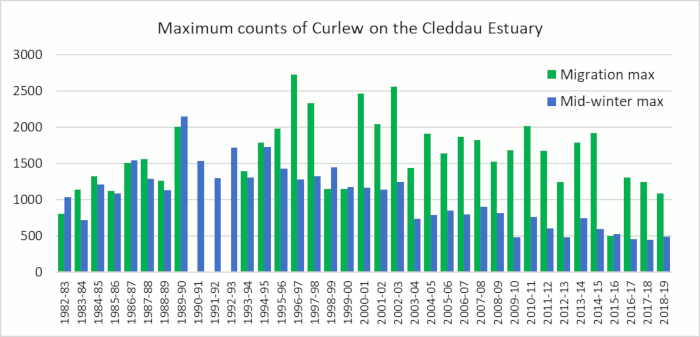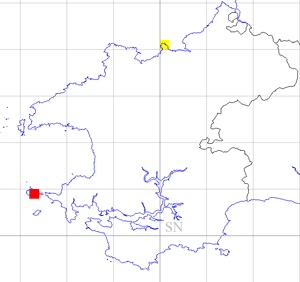Curlew - 2019 WeBS
 Tuesday, March 31, 2020 at 9:12AM
Tuesday, March 31, 2020 at 9:12AM 


 Pembrokeshire Avifauna committee | Comments Off |
Pembrokeshire Avifauna committee | Comments Off |  Tuesday, March 31, 2020 at 9:12AM
Tuesday, March 31, 2020 at 9:12AM 


 Friday, September 20, 2013 at 9:11AM
Friday, September 20, 2013 at 9:11AM Numenius arquata arquata
Mathew had "little doubt" that it nested on Prescelly Mountain, and also "occasionally" on Skomer. It is an abundant visitor to the coasts, especially in autumn and winter. Before the early 1930s it was not common as a breeder, but it has greatly increased and now nests throughout the county, except the Castlemartin peninsula. Large flocks resort to the islands during the moult, and it breeds frequently Skomer and Ramsey. Most numerous as a breeder in the mountainous northern half of the county.
R.M.Lockley, G.C.S.Ingram, H.M.Salmon, 1949, The Birds of Pembrokeshire, The West Wales Field Society
 Monday, May 7, 2012 at 5:02PM
Monday, May 7, 2012 at 5:02PM By the 1980s it was estimated that only about 20 pairs were still breeding in Pembrokeshire. Of these, the majority (13 pairs) were on Skomer, with the rest in the boggy areas of the Preseli Hills. Between 2003 and 2007 the number of tetrads in which they were found had shrunk to just two from 12 recorded during the 1984-88 period, a decline of 83%.
They were only confirmed breeding on Skomer where six to nine pairs nested during the 2003-7 atlas period. The breeding population in Wales is also in trouble - BBS records indicate a 33% decline in the population between 1994 and 2007 across Wales as a whole, based on 37 sample sites.
Further research is needed to determine if former mainland haunts in Pembrokeshire are capable of supporting breeding curlews again.
Bob Haycock

Fieldwork 2003-07 (based on 490 tetrads)
Red = breeding confirmed = 1
Orange = breeding probable = 0
Yellow = breeding possible = 1
Total tetrads in which registered = 2 (0.4%)
 PBBA 2003-7,
PBBA 2003-7,  RJH in
RJH in  Curlew
Curlew  Thursday, November 24, 2011 at 9:15PM
Thursday, November 24, 2011 at 9:15PM Breeding resident, winter visitor and passage migrant
According to Mathew (1894) curlews bred on the Preseli Mountains and occasionally on Skomer. Lockley et al (1949) stated that they were not common as a breeding bird before the early 1930s, but greatly increased afterwards to breed throughout the county, including Ramsey and Skomer but not the Castle Martin peninsula, being most numerous in the north. Lloyd’s diaries indicate that they were a widespread breeding species in Pembrokeshire by 1927. The breeding range extended to the Castle Martin peninsula in about 1950 (Lockley 1961)
Extensive land reclamation and drainage was to follow, while traditional grazing of common land decreased, modifying the tussocky structure and permitting invasion by scrub. The curlew’s breeding range retracted and Saunders (1976) found them nesting in only small numbers. The decline continued, curlews last occupying breeding grounds at Rosebush in 1980, Slade Bottom near Puncheston and Dowrog common in 1983. The Breeding Birds Survey of 1984-1988 found only about 20 pairs, 13 on Skomer and the rest on bogs in the Preseli Mountains, although they were also present in the breeding season in the meadows around the junctions of the rivers Syfynwy and Easter Cleddau.
They are much more widespread outside the breeding season. A few non-breeders are present in late May and early June, numbers building up quickly during July and peaking in September before settling back to the winter level. A rapid departure takes place in March and early April, Numbers reach 600 on the Teifi estuary, up to 450 on the Nevern estuary, and 100 in Fishguard Harbour, but they are not confined to estuaries, being found also on beaches and field all around the coastline, as well as on the offshore islands. The average total mid-winter population is probably about 3000 birds.
They migrate by day as well as by night, being seen flying in off the sea along the snorth coast and down the west coast in autumn, and arriving from the south of the southern shores in the spring. They are not infrequently heard passing over the county at night, and have been noted at lighthouse attractions at the Smalls and Strumble Head.
Ringing has shown that curlews from northern Britain and Finland visit Pembrokeshire.

Fieldwork 1984-88 (based on 478 tetrads)
Red = breeding confirmed = 2
Orange = breeding probable = 6
Yellow = breeding possible = 4
Total tetrads in which registered = 12 (2.5%)
Donovan J.W. & Rees G.H (1994), Birds of Pembrokeshire
 Friday, November 11, 2011 at 12:05PM
Friday, November 11, 2011 at 12:05PM 
Red = breeding confirmed
Orange = breeding probable
Yellow = breeding possible
 Friday, September 16, 2011 at 12:08PM
Friday, September 16, 2011 at 12:08PM 
The BTO winter atlas showed that Curlews were present in most 10km squares during the winters of 1981-82, 1982-82 and 1983-84.
The darker the colour, the higher the relative total count for each 10km square, the darkest blue represents over 210 birds.
The distribution is consistent with the Birds of the Estuary Enquiry (BoEE, now WeBS) at that time, with the majority of birds in the Cleddau Estuary complex. The Nevern and Teifi estuaries provided most winter records in the north of the county.
Graham Rees
 Monday, February 28, 2011 at 6:19PM
Monday, February 28, 2011 at 6:19PM Species account from M Mathew, 1894, "The Birds of Pembrokeshire and its islands"
